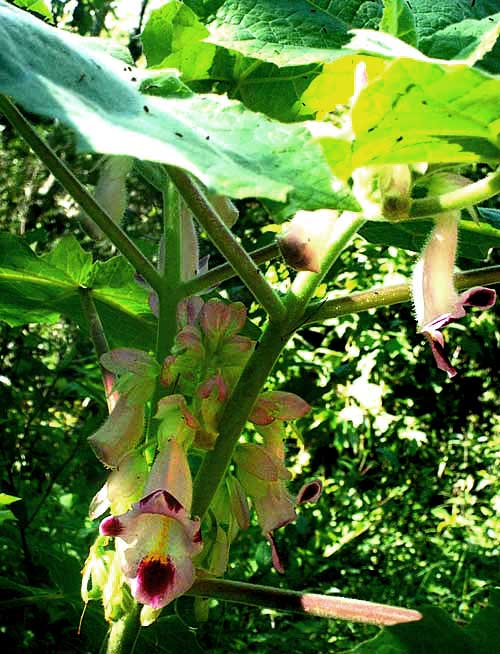Excerpts from Jim Conrad's
Naturalist Newsletter
from the September 14, 2007 Newsletter issued from Sierra Gorda Biosphere Reserve, QUERÉTARO, MÉXICO
DEVIL'S CLAWS FROM PRETTY FLOWERS
Along weedy roadsides nowadays there's a knee-high herb graced with strikingly pretty clusters of drooping, 1.5-inch-long blossoms, which you can see below:

Notice how each flower's corolla is provided with a large lower lip where pollinating insects such as bees can land, then follow yellow nectar guides to where the nectar is. The entire plant, including the flowers, is invested with gland-topped hairs, giving the parts a velvety, sticky feeling. In the picture you can see debris and tiny insects adhering to all parts. This is an unusual plant, and assigning it to its family makes a good exercise.
One reason for that is that the species is MARTYNIA ANNUA, a member of the Martynia Family, the Martyniaceae, which isn't a well-known family. Often plants in the family are called "Devil's Claws" because of the 2-hooked form of their seed pods. The fruits are well adapted for dispersal by large mammals, maybe even mammals long extinct. A whole page just about the hitchhiking abilities of fruits in this family is at https://www2.palomar.edu/users/warmstrong/ww0801.htm#martynia.
Martynia annua is native to Mexico and Central America but its excellent dispersal mechanism has helped it spread throughout the tropical world as a weed. I read that "In novelty shops of Mexico the pods of Martynia annua are hooked around a central disk to form a clever decorative sunflower."
In India the plant has been known long enough for it to constitute part of the traditional pharmacopia. Its leaf juice is gargled for sore throats, oil from its fruits and seeds is smeared onto scabies infections, a paste of the seeds and fruits is thought to be effective for bites of venomous insects and scorpions, and more.